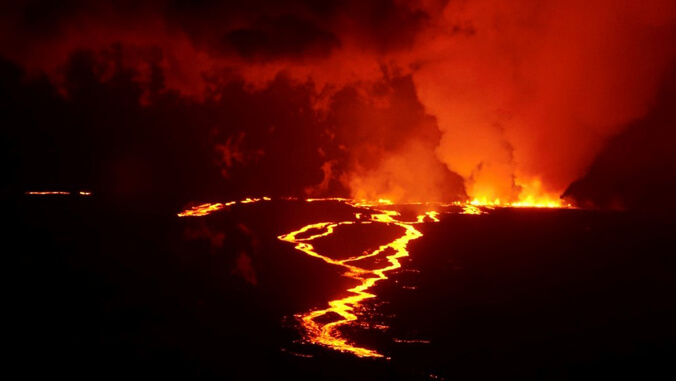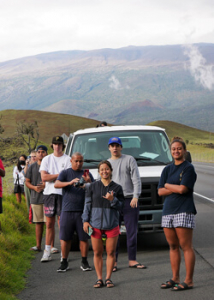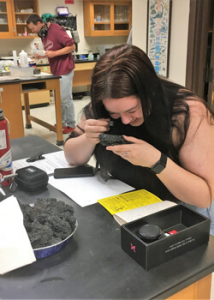
The eruption of Maunaloa has created a fiery living laboratory and real world classroom for students, faculty and staff at the University of Hawaiʻi at Hilo.

Steve Lundblad, a geology professor, took his introductory geology class on an excursion two days after the first fissure opened to safely view the flow from Saddle Road. They based their observations at Gilbert Kahele Park.
“We talked about Maunaloa and Maunakea, and the Maunakea cinder cones surrounded by newer Maunaloa lava flows,” Lundblad explained. He expressed, students were mostly busy looking at the eruption through binoculars.
The curriculum of Lundblad’s class is designed to prepare students for further studies in geology. They study the features and materials that make up Earth, with emphasis on structures, various erosional and depositional processes, and the role of plate tectonics.
Lava sample study

Staff from the U.S. Geological Survey’s Hawaiian Volcano Observatory (USGS-HVO) continue to collect and bring samples of fresh lava to the UH Hilo Geoarchaeology Laboratory for analysis on the Energy Dispersive X-Ray Fluorescence spectrometer, commonly called the EDXRF machine, which analyzes groups of elements simultaneously.
“Our student worker Baylee McDade will help prepare the samples, grinding them into powder, for analysis on the EDXRF machine…after the rocks finish in the drying oven,” said Darcy Bevens, an educational specialist at the UH Hilo Center for the Study of Active Volcanoes.
“The analysis will give HVO details about the composition of the rock,” Bevens added.
Lundblad and colleague Peter Mills, an anthropology professor, have operated the X-Ray Fluoresence Spectrometer for the past 20 years, working on archaeological materials.
In past years, they also have worked with geology lecturer Cheryl Gansecki on newly erupted samples from Kīlauea—and now this week, Maunaloa—to track changes in the eruption. They do this by taking samples from the active flows, which are run through the EDXRF machine and analyzed for changes from one sample to the next.
In-depth tracking

UH Hilo has been analyzing lava flow samples from Kīlauea since 2013 however the composition barely changed until May 2018. First there was magma that had been stored, older, colder, and then as the fissures progressed, the scientists started to see, younger, hotter, magma coming in. This type of lava is more fluid and can travel longer distances.
“We successfully tracked changes during the 2018 eruption from magma that was stored in the lower East Rift zone to new magma that traveled from the summit reservoir,” Lundblad said.
The chemical change detected by the UH Hilo team preceded the change in Kīlauea’s eruptive behavior by two to three days which gave officials advanced warning in their task of protecting the public.
Now the UH Hilo team is at work on the Maunaloa flows.
“Because Maunaloa is a new eruption, we are hoping to help the USGS-HVO folks track changes from the early phases of the eruption to later stages,” Lundblad said.
For more information go to UH Hilo Stories.


